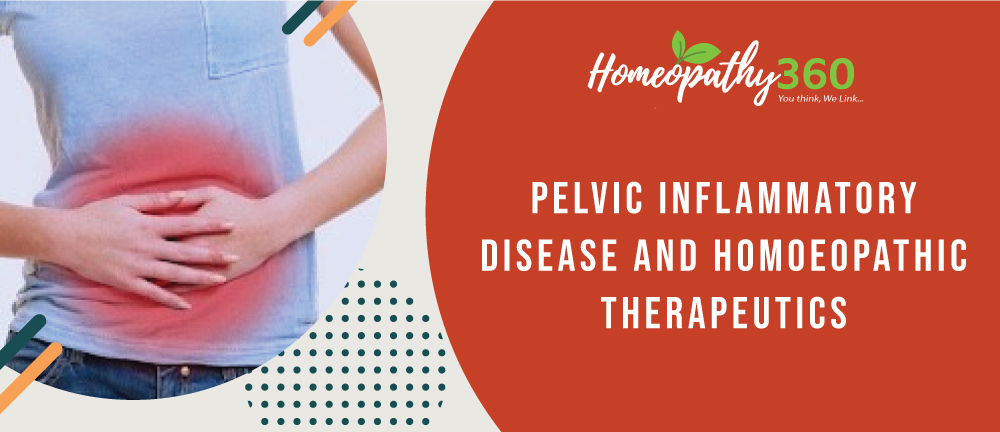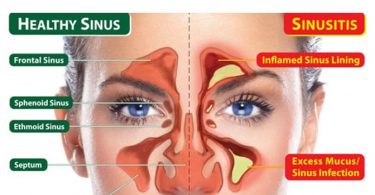
Abstract
PID is an infectious disease affecting the upper part of female genital tract, most commonly women of reproductive age group. It affects mainly uterus, fallopian tubes, ovaries, pelvic peritoneum and surrounding structures. Spread of infection mainly occurs by ascent of pathogenic organisms from vagina to upper genital tract. 60-75% of PIDs are caused by sexual transmission of Neisseria Gonorrhoea and Chlamydia Trachomatis, Mycoplasma Hominis others are Staphylococcus, E. Coli and Streptococci.
The incidence of PID varies from 1–2% per year among sexually active women. About 85% are spontaneous infection in sexually active females of reproductive age. PID is well managed with Homoeopathic therapeutics, mainly in acute PIDs by preventing recurrence and further complications like infertility.
Definition
Pelvic inflammatory disease (PID) implies infection and inflammation of the upper genital tract involving the uterus, fallopian tubes, ovaries, pelvic peritoneum & surrounding structures.
Key words
Pelvic inflammatory disease (PID), Homoeopathic therapeutics
Risk factors
- Menstruating teenagers
- Multiple sexual partners
- Previous history of acute PID
- IUCD users
- Area with high prevalence of sexually transmitted diseases
Aetiology
PID is a polymicrobial infection that ascends from vagina to upper female genital tract by spread through mucosal contiguity; and sexually transmitted vectors like sperms and trichomonads. It also spreads to fallopian tubes due to reflux of menstrual blood along with gonococci. 40 to 50% of PIDs are result of post-abortal & puerperal sepsis as a result of failure in aseptic measures.
Minor operative procedures like D & C, Hysterosalpingogram, manual removal of placenta and evacuation of products of conception lead to PIDs. Prevalence of infection by Actinomycetes is seen among 7% of IUCD users. Secondary infections after appendicitis and diverticulitis also result in pelvic peritonitis.
Pathology
- Infection is most common following intercourse, post abortal, gynaecological procedures and menses due to loss of genital defence. Inflammation starts in fallopian tubes usually bilateral, leading to destruction of cilia and microvilli of endosalpinx. In severe infections all layers of tube are involved , become edematous and hyperaemic.
- The exfoliated cells along with the exudate pour into the lumen of the tube and agglutinate the mucosal folds. The closure of both the ostia results in pent up of the exudate inside the tube. Depending upon the virulence, the exudate may be watery producing hydrosalpinx or purulent producing pyosalpinx. Rarely the exudate pours through the abdominal ostium to produce pelvic peritonitis and pelvic abscess or may affect the ovary producing ovarian abscess.
- Failure of acute pelvic infection to resolve or end result of acute infection results in chronic tubo-ovarian masses. These masses manifest in the form of Hydrosalpinx ,Chronic pyosalpinx, Chronic interstitial salpingitis ,Tubo-ovarian cyst and Tuberculous form
Protective Factors
- Physiological factors
- Intact hymen
- Vagina – acidic secretions
- Cervical canal – alkaline mucus plug formation
- Endometrial lining of uterus and cervix – downward motion of cilia
- Contraceptive factors
- Barrier methods – condom, diaphragm with spermicides
- Sterilisation – tubal ligation prevents ascent of infection
- Oral steroidal contraceptives – mucus plug formation and reduction in time of menstruation prevent colonisation of bacteria
- Monogamy
- Others
- Pregnancy
- Menopause
Clinical features
Symptoms
Symptoms usually appear at the time and immediately after the menstruation
- Bilateral lower abdominal and pelvic pain which is dull in nature
- Abnormal vaginal discharge.
- Abnormal uterine bleeding.
- Dyspareunia
- Pain and discomfort in the right hypochondrium due to concomitant perihepatitis (Fitz-Hugh-Curtis Syndrome)
Signs
- Fever > 38°C
- Abdominal
palpation
- Tenderness on both the quadrants of lower abdomen.
- The liver may be enlarged and tender
- Vaginal
examination reveals
- Abnormal vaginal discharge which may be of purulent
- Congested external urethral meatus or openings of Bartholin’s ducts through which pus may be seen escaping out on pressure
- Speculum examination – congested cervix with purulent discharge from the canal
- Bimanual
examination
- Cervical motion tenderness
- Adnexal tenderness
Diagnostic criteria
Minimum Criteria
- Lower abdominal tenderness.
- Adnexal tenderness.
- Cervical motion tenderness.
Additional Criteria
- Oral temperature > 38.3°C.
- Mucopurulent cervical or vaginal discharge.
- Raised C-reactive protein and/or ESR.
- Laboratory documentation of positive cervical
- infection with Gonorrhoea or C. trachomatis
Definitive Criteria
- Histopathologic evidence of endometritis on biopsy
- Imaging study (TVS/MRI) evidence of thickened fluid filled tubes ± tubo-ovarian complex
- Laparoscopic evidence of PID
Investigation findings
- Gram stain and
Culture
- Discharge collected from Urethra/ Bartholin’s gland , cervical canal ,
- Pus collected from fallopian tubes during Laparoscopy
- Gram-negative diplococci are very much suggestive of gonococcal infection
- Male Partner – smear and culture are made from urethral secretion
- Sonography of Pelvis
- Dilated and fluid filled tubes, fluid in the pouch of Douglas or adnexal mass are suggestive of PID
- Blood
- Serological test for syphilis should be carried out for both the partners in all cases
- Leucocyte count – leukocytosis > 10,000 per cu mm
- Elevated ESR >15 mm per hour
- CRP raised
- Laparoscopy – Gold
standard, indicates Severity of PID
- Mild: Tubes: edema, erythema, no purulent exudates and mobile.
- Moderate: Purulent exudates from the fimbrial ends, tubes not freely movable
- Severe: Pyosalpinx, inflammatory complex, abscess
- ‘Violin string’ like adhesions in the pelvis and around the liver suggests – chlamydial infection.
- Culdocentesis
- Aspiration of peritoneal fluid and its white cell count, if exceeds 30,000 per mL. is significant in acute PID
Complications
Immediate
- Pelvic peritonitis
- Septicaemia
Late
- Dyspareunia
- Infertility
- Risk of Ectopic Pregnancy
- Chronic pelvic pain
- Fitz Hugh Curtis Syndrome
Differential diagnosis
- Acute appendicitis
- Ectopic gestation
- Twisted ovarian cyst
- Septic abortion
- Diverticulitis
- Cholecystitis
General Management
- Usage of barrier methods
- Usage of hormonal combined contraceptive pills than IUCDs
- Screening for sexually transmitted diseases in both partners
- Maintenance of aseptic conditions during deliveries and gynaecological procedures
Homoeopathic management
- Ambra grisea
Nymphomania. Profuse, bluish leucorrhoea, worse at night. Itching of pudendum with soreness & swelling. Discharge of blood between periods at every little incident.
- Ammonium Mur
Leucorrhoea like white of egg preceded by gripping pain about the navel; Brown, slimy discharge, after menses. Leucorrhoea follows after every urination. Diarrhoea and vomiting , bloody discharge from the bowels during menses, flow more profuse at night
- Antimonium Tart
Chronic cervicitis, cervix much enlarged with superficial erosion about os. Leucorrhoea of watery blood < when sitting, comes in paroxysms. Chronic metritis with feeling of weight tugging at coccyx. Menses too early, weak and only for two days. Menses of watery blood.
- Aurum Met
Menstrual and uterine affections with great melancholy. Syphilitic or scrofulous leucorrhoea, discharge profuse, yellow, corroding or thick, white with prolapsus uteri, greatly aggravated by walking. Vaginismus.
- Belladonna
Acute endometritis, cervix sensitive swollen, reddened, bearing down pains with leucorrhoea as if everything would be forced out through vulva. Leucorrhoea most copious in the morning < sitting bent and walking.
- Cannabis Sativa
Acute gonorrhoea. Threatened abortion, complicated with gonorrhoea or on account of frequent sexual intercourse. Infantile leucorrhoea. Great sexual excitement with infertility
- Carbolic Acid
Copious discharge of fetid, greenish, acrid matter from the vagina, with uterine catarrh. Dragging sensation across the loins through pelvis; frequent desire to urinate with burning pain in urethra. Painful swelling of left ovary. Induration and erosions of cervix. Thick irritating leucorrhoea causing itching and burning. Puerperal fever with offensive discharge.
- Cedron
Leucorrhoea regularly every month, five or six days previous to menses with pain in uterus and swelling of vulva. Leucorrhoea instead of menses
- Erigeron
Pregnant woman with a weak uterus. Bloody discharge on slight exertion. Profuse uterine and vaginal leucorrhoea with spasmodic pains and irritation of bladder and rectum. Bloody lochia returns after least motion, comes in gushes, between periods.
- Eupionum
Gushing leucorrhoea, yellow, staining. Leucorrhoea with severe backache after menses, when the pain in back ceases, leucorrhoea gushes out. Sore pain between labia during urination. Burning in the right ovary. Chronic tubal disease. Uterine displacements.
- Hydrastis
Endometritis. Erosion and excoriation of cervix. Leucorrhoea worse after menses; Thick acrid yellow, ropy corroding discharge. Pruritis vulva with profuse leucorrhoea. Hot, watery discharge from uterus. Uterine complaints better recumbent posture. Removes tendency to habitual adherent placenta. Inflammation of cervix with heat and itching of vagina. Vagina sore during coition, bleeding afterwards.
- Medorrhinum
For women with chronic ovaritis, salpingitis, pelvic cellulitis, fibroids, cysts and other morbid growths of the uterus & ovaries. Menses offensive, profuse, dark, clotted. Stains difficult to wash. Leucorrhoea thin, acrid, excoriating, fishy odour. Ovarian pain worse left side, or from ovary to ovary. Sterility
- Platina
Parts hypersensitive, cannot bear the napkin to touch her; will go onto spasms from examination. Ovaries sensitive & burn. Ovaritis with sterility. Menses early, profuse, long lasting, dark clotted, offensive, with bearing down pains in uterus. Vaginismus from excessive sensitiveness of sexual organs, coition is impossible (Staph)
- Sepia
Never well since puberty, childbirth, after weaning or hormonal pills. Dryness of vagina after menses. Coition painful, aversion to coition. Leucorrhoea yellow, greenish, milky in large lumps; with much itching, instead of menses. Violent stitches upward in the vagina; lancinating pains from uterus to umbilicus. Pressure & bearing down as if everything everything would escape through pelvis, must cross limbs tightly
- Syphilinum
Menses, with putrid meat like odour. Leucorrhoea profuse, thin, watery, acrid with sharp, knife-like pain in ovaries. Very profuse, soaks through the napkin & runs down to heels, with itching of genitals
References
- Konar H. DC Dutta’s textbook of gynecology. JP Medical Ltd; 2016 Jun 30.
- Howkins J, Bourne G. Shaw’s textbook of gynaecology. Edinburgh: Churchill Livingstone; 1971.
- Clarke JH. A clinical repertory to the dictionary of materia medica: together with repertories of causation, temperaments, clinical relationships, natural relationships. B. Jain Publishers; 1975.
- Boericke W. New manual of homoeopathic materia medica and repertory. B. Jain Publishers; 2001.
- Lilienthal S. Homoeopathic therapeutics. B. Jain Publishers; 1998.
- Murphy R. Lotus materia medica. B. Jain Publishers; 2003.
Dr. Dharanni .V
PG Scholar, Department of Materia Medica
Father Muller Homoeopathic Medical College
Deralakatte, Mangalore -575018





